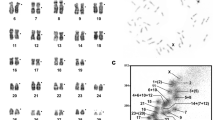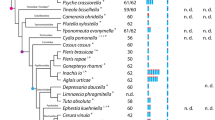Abstract
Comparative genomics is an important and expanding field of research, and the genome-wide comparison of the chromosome constitution of different species makes a major contribution to this field. Cross-species chromosome painting is a powerful technique for establishing chromosome homology maps, defining the sites of chromosome fusions and fissions, investigating chromosome rearrangements during evolution and constructing ancestral karyotypes. Here the protocol for cross-species chromosome painting is presented. It includes sections on cell culture and metaphase preparation, labeling of chromosome-specific DNA, fluorescent in situ hybridization (chromosome painting) and image analysis. Cell culture and metaphase preparation can take between 1 and 2 wk depending on the cell culture. Labeling of chromosome-specific DNA is completed in 1 d. Fluorescent in situ hybridization can be completed in a maximum of 4 d.
This is a preview of subscription content, access via your institution
Access options
Subscribe to this journal
Receive 12 print issues and online access
$259.00 per year
only $21.58 per issue
Buy this article
- Purchase on Springer Link
- Instant access to full article PDF
Prices may be subject to local taxes which are calculated during checkout


Similar content being viewed by others
References
Wienberg, J., Jauch, A., Stanyon, R. & Cremer, T. Molecular cytotaxonomy of primates by chromosomal in situ suppression hybridization. Genomics 8, 347–350 (1990).
Jauch, A. et al. Reconstruction of genomic rearrangements in great apes and gibbons by chromosome painting. Proc. Natl. Acad. Sci. USA 89, 8611–8615 (1992).
Scherthan, H. et al. Comparative chromosome painting discloses homologous segments in distantly related mammals. Nat. Genet. 6, 342–347 (1994).
Yang, F., Carter, N.P., Shi, L. & Ferguson-Smith, M.A. A comparative study of karyotypes of muntjacs by chromosome painting. Chromosoma 103, 642–652 (1995).
Wienberg, J. & Stanyon, R. Chromosome painting in mammals as an approach to comparative genomics. Curr. Opin. Genet. Dev. 5, 792–797 (1995).
Goureau, A. et al. Human and porcine correspondence of chromosome segments using bidirectional chromosome painting. Genomics 36, 252–262 (1996).
Müller, S., O'Brien, P.C.M., Ferguson-Smith, M.A. & Wienberg, J. Reciprocal chromosome painting between human and prosimians (Eulemur macaco macaco and E. fulvus mayottensis). Cytogenet. Cell Genet. 78, 260–271 (1997).
Wienberg, J. et al. Conservation of human vs. feline genome organization revealed by reciprocal chromosome painting. Cytogenet. Cell Genet. 77, 211–217 (1997).
Yang, F. et al. Chromosomal evolution of the Chinese muntjac (Muntiacus reevesi). Chromosoma 106, 37–43 (1997).
Yang, F., Muller, S., Just, R., Ferguson-Smith, M.A. & Wienberg, J. Comparative chromosome painting in mammals: human and the Indian muntjac (Muntiacus vaginalis). Genomics 39, 396–401 (1997).
Yang, F., O'Brien, P.C.M., Wienberg, J. & Ferguson-Smith, M.A. A reappraisal of the tandem fusion theory of karyotype evolution in the Indian Muntjac using chromosome painting. Chromosome Res. 50, 109–117 (1997).
Murphy, W.J. et al. Dynamics of mammalian chromosome evolution inferred from multispecies comparative maps. Science 309, 613–617 (2005).
Schrock, E. et al. Multicolor spectral karyotyping of human chromosomes. Science 273, 494–497 (1996).
Rens, W., Yang, F., O'Brien, P.C., Solanky, N. & Ferguson-Smith, M.A. A classification efficiency test of spectral karyotyping and multiplex fluorescence in situ hybridization: identification of chromosome homologies between Homo sapiens and Hylobates leucogenys. Genes Chromosomes Cancer 31, 65–74 (2001).
Neusser, M., Stanyon, R., Bigoni, F., Wienberg, J. & Muller, S. Molecular cytotaxonomy of New World monkeys (Platyrrhini) — comparative analysis of five species by multi-color chromosome painting gives evidence for a classification of Callimico goeldii within the family of Callitrichidae. Cytogenet. Cell Genet. 94, 206–215 (2001).
Murphy, W.J., Fronicke, L., O'Brien, S.J. & Stanyon, R. The origin of human chromosome 1 and its homologs in placental mammals. Genome Res. 13, 1880–1888 (2003).
Yang, F. et al. Reciprocal chromosome painting among human, aardvark, and elephant (superorder Afrotheria) reveals the likely eutherian ancestral karyotype. Proc. Natl. Acad. Sci. USA 100, 1062–1066 (2003).
Stanyon, R., Dumas, F., Stone, G. & Bigoni, F. Multidirectional chromosome painting reveals a remarkable syntenic homology between the greater galagos and the slow loris. Am. J. Primatol. 68, 349–359 (2006).
Yang, F. et al. Comparative genome maps of the pangolin, hedgehog, sloth, anteater and human revealed by cross-species chromosome painting: further insight into the ancestral karyotype and genome evolution of eutherian mammals. Chromosome Res. 14, 283–296 (2006).
Ye, J. et al. Cross-species chromosome painting unveils cytogenetic signatures for the Eulipotyphla and evidence for the polyphyly of Insectivora. Chromosome Res. 14, 151–159 (2006).
Müller, S., O'Brien, P.C.M., Ferguson-Smith, M.A. & Wienberg, J. Cross-species colour segmenting: a novel tool in human karyotype analysis. Cytometry 33, 1–8 (1998).
Stanyon, R. et al. Reciprocal chromosome painting shows that genomic rearrangements between rat and mouse proceeds ten times faster than between human and cats. Cytogenet. Cell Genet. 84, 150–155 (1999).
O'Brien, S.J. et al. The promise of comparative genomics in mammals. Science 286, 458–462 (1999).
Glas, R., Graves, J.A., Toder, R., Ferguson-Smith, M. & O'Brien, P.C.M. Cross-species chromosome painting between human and marsupial directly demonstrates the ancient region of the mammalian X. Mamm. Genome 10, 1115–1116 (1999).
Rens, W. et al. Reversal and convergence in marsupial chromosome evolution. Cytogenet. Genome Res. 102, 282–290 (2003).
Rens, W. et al. Resolution and evolution of the duck-billed platypus karyotype with an X1Y1X2Y2X3Y3X4Y4X5Y5 male sex chromosome constitution. Proc. Natl. Acad. Sci. USA 101, 16257–16261 (2004).
Grutzner, F. et al. In the platypus a meiotic chain of ten sex chromosomes shares genes with the bird Z and mammal X chromosomes. Nature 432, 913–917 (2004).
Griffin, D.K. et al. Micro- and macrochromosome paints generated by flow cytometry and microdissection: tools for mapping the chicken genome. Cytogenet. Cell Genet. 87, 278–281 (1999).
Shetty, S., Griffin, D.K. & Graves, J.A. Comparative painting reveals strong chromosome homology over 80 million years of bird evolution. Chromosome Res. 7, 289–295 (1999).
Chowdhary, B.P. & Raudsepp, T. HSA4 and GGA4: remarkable conservation despite 300-Myr divergence. Genomics 64, 102–105 (2000).
Nanda, I. et al. Extensive gross genomic rearrangements between chicken and Old World vultures (Falconiformes: Accipitridae). Cytogenet. Genome Res. 112, 286–295 (2006).
Speicher, M.R. & Carter, N.P. The new cytogenetics: blurring the boundaries with molecular biology. Nature 6, 782–792 (2005).
Speicher, M.R., Gwyn Ballard, S. & Ward, D.C. Karyotyping human chromosomes by combinatorial multi-fluor FISH. Nat. Genet. 12, 368–375 (1996).
Müller, S., Rocchi, M., Ferguson-Smith, M.A. & Wienberg, J. Toward a multicolor chromosome bar code for the entire human karyotype by fluorescence in situ hybridization. Hum. Genet. 100, 271–278 (1997).
Müller, S., Neusser, M. & Wienberg, J. Towards unlimited colors for fluorescence in-situ hybridization (FISH). Chromosome Res. 10, 223–232 (2002).
Mrasek, K. et al. Detailed Hylobates lar karyotype defined by 25-color FISH and multicolor banding. Int. J. Mol. Med. 12, 139–146 (2003).
Telenius, H. et al. Cytogenetic analysis by chromosome painting using DOP-PCR amplified flow-sorted chromosomes. Genes Chromosomes Cancer 4, 257–263 (1992).
Rens, W. et al. A procedure for image enhancement in chromosome painting. Chromosome Res. 14, 497–503 (2006).
Acknowledgements
The authors are indebted to F. Yang, who contributed greatly to the development of the cross-species painting protocol. The protocol is being developed and used at the Cambridge Resource Centre for Comparative Genomics at the University of Cambridge, which is supported by a generous grant from the Wellcome Trust.
Author information
Authors and Affiliations
Corresponding author
Ethics declarations
Competing interests
The authors declare no competing financial interests.
Rights and permissions
About this article
Cite this article
Rens, W., Fu, B., O'Brien, P. et al. Cross-species chromosome painting. Nat Protoc 1, 783–790 (2006). https://doi.org/10.1038/nprot.2006.91
Published:
Issue Date:
DOI: https://doi.org/10.1038/nprot.2006.91
This article is cited by
-
Chromosomal conservatism vs chromosomal megaevolution: enigma of karyotypic evolution in Lepidoptera
Chromosome Research (2023)
-
Chromosome evolution in Iberolacerta, a genus that deviates from the standard karyotype formula of Lacertidae
Genetica (2023)
-
Oligo-painting and GISH reveal meiotic chromosome biases and increased meiotic stability in synthetic allotetraploid Cucumis ×hytivus with dysploid parental karyotypes
BMC Plant Biology (2019)
-
Derivation and maintenance of mouse haploid embryonic stem cells
Nature Protocols (2019)
-
Chromosome painting and its applications in cultivated and wild rice
BMC Plant Biology (2018)
Comments
By submitting a comment you agree to abide by our Terms and Community Guidelines. If you find something abusive or that does not comply with our terms or guidelines please flag it as inappropriate.



